Page 64 of 420
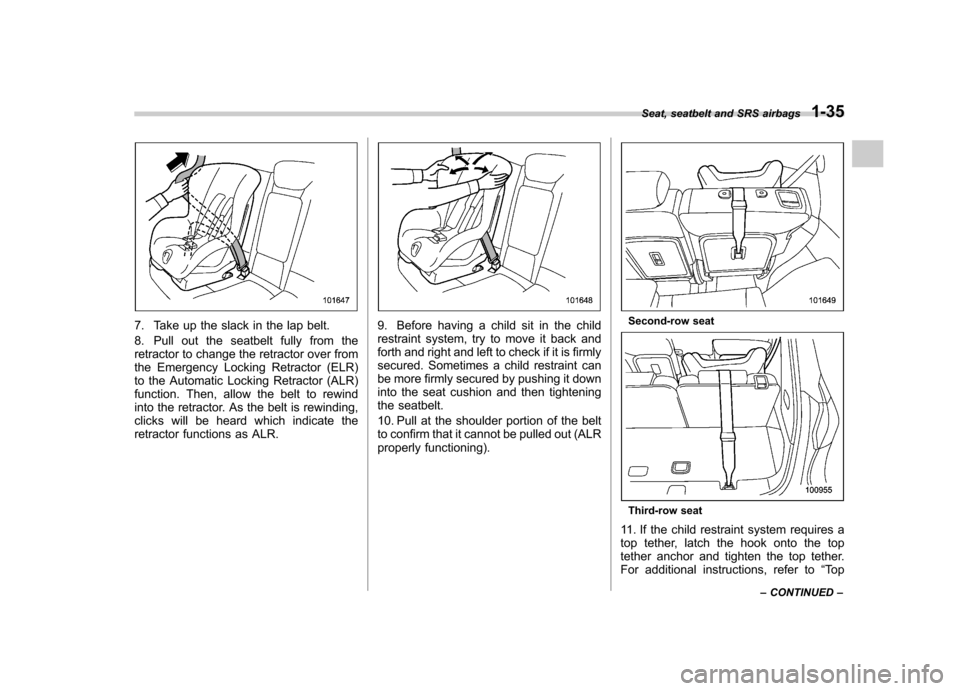
7. Take up the slack in the lap belt.
8. Pull out the seatbelt fully from the
retractor to change the retractor over from
the Emergency Locking Retractor (ELR)
to the Automatic Locking Retractor (ALR)
function. Then, allow the belt to rewind
into the retractor. As the belt is rewinding,
clicks will be heard which indicate the
retractor functions as ALR.9. Before having a child sit in the child
restraint system, try to move it back and
forth and right and left to check if it is firmly
secured. Sometimes a child restraint can
be more firmly secured by pushing it down
into the seat cushion and then tightening
the seatbelt.
10. Pull at the shoulder portion of the belt
to confirm that it cannot be pulled out (ALR
properly functioning).Second-row seat
Third-row seat
11. If the child restraint system requires a
top tether, latch the hook onto the top
tether anchor and tighten the top tether.
For additional instructions, refer to “To p
Seat, seatbelt and SRS airbags
1-35
– CONTINUED –
Page 65 of 420
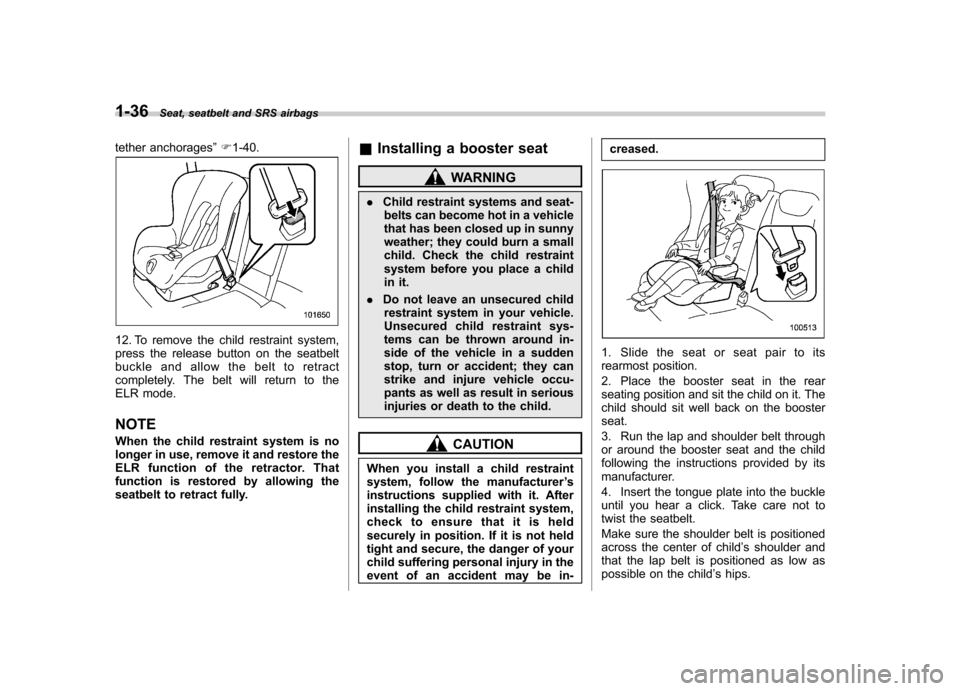
1-36Seat, seatbelt and SRS airbags
tether anchorages ”F 1-40.
12. To remove the child restraint system,
press the release button on the seatbelt
buckle and allow the belt to retract
completely. The belt will return to the
ELR mode. NOTE
When the child restraint system is no
longer in use, remove it and restore the
ELR function of the retractor. That
function is restored by allowing the
seatbelt to retract fully. &
Installing a booster seat
WARNING
. Child restraint systems and seat-
belts can become hot in a vehicle
that has been closed up in sunny
weather; they could burn a small
child. Check the child restraint
system before you place a child
in it.
. Do not leave an unsecured child
restraint system in your vehicle.
Unsecured child restraint sys-
tems can be thrown around in-
side of the vehicle in a sudden
stop, turn or accident; they can
strike and injure vehicle occu-
pants as well as result in serious
injuries or death to the child.
CAUTION
When you install a child restraint
system, follow the manufacturer ’s
instructions supplied with it. After
installing the child restraint system,
check to ensure that it is held
securely in position. If it is not held
tight and secure, the danger of your
child suffering personal injury in the
event of an accident may be in- creased.
1. Slide the seat or seat pair to its
rearmost position.
2. Place the booster seat in the rear
seating position and sit the child on it. The
child should sit well back on the boosterseat.
3. Run the lap and shoulder belt through
or around the booster seat and the child
following the instructions provided by its
manufacturer.
4. Insert the tongue plate into the buckle
until you hear a click. Take care not to
twist the seatbelt.
Make sure the shoulder belt is positioned
across the center of child
’s shoulder and
that the lap belt is positioned as low as
possible on the child ’s hips.
Page 66 of 420
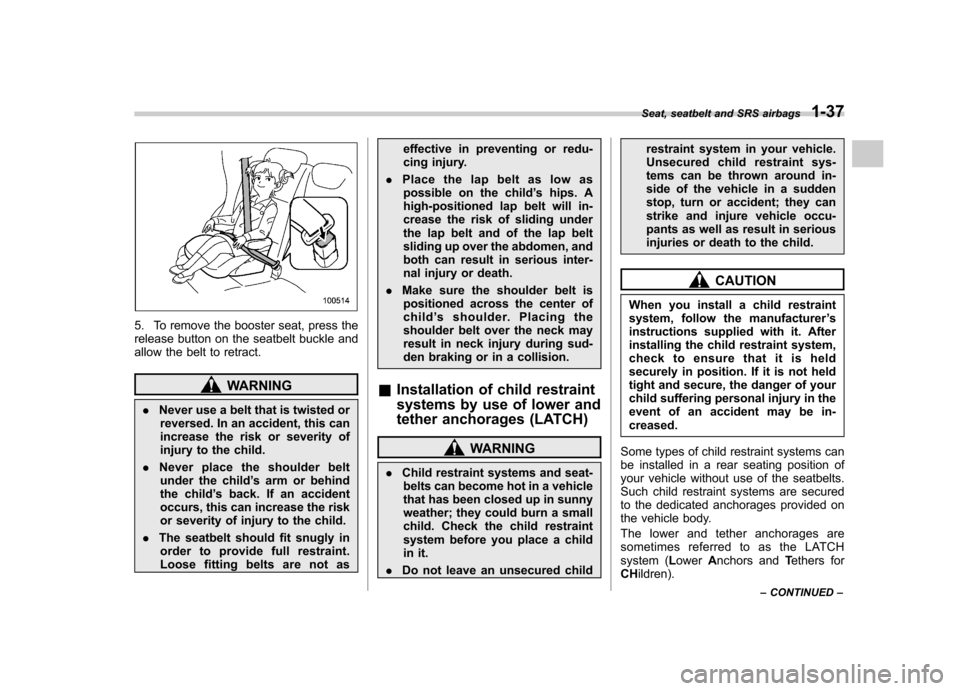
5. To remove the booster seat, press the
release button on the seatbelt buckle and
allow the belt to retract.
WARNING
. Never use a belt that is twisted or
reversed. In an accident, this can
increase the risk or severity of
injury to the child.
. Never place the shoulder belt
under the child ’s arm or behind
the child ’s back. If an accident
occurs, this can increase the risk
or severity of injury to the child.
. The seatbelt should fit snugly in
order to provide full restraint.
Loose fitting belts are not as effective in preventing or redu-
cing injury.
. Place the lap belt as low as
possible on the child ’s hips. A
high-positioned lap belt will in-
crease the risk of sliding under
the lap belt and of the lap belt
sliding up over the abdomen, and
both can result in serious inter-
nal injury or death.
. Make sure the shoulder belt is
positioned across the center of
child ’s shoulder. Placing the
shoulder belt over the neck may
result in neck injury during sud-
den braking or in a collision.
& Installation of child restraint
systems by use of lower and
tether anchorages (LATCH)
WARNING
. Child restraint systems and seat-
belts can become hot in a vehicle
that has been closed up in sunny
weather; they could burn a small
child. Check the child restraint
system before you place a child
in it.
. Do not leave an unsecured child restraint system in your vehicle.
Unsecured child restraint sys-
tems can be thrown around in-
side of the vehicle in a sudden
stop, turn or accident; they can
strike and injure vehicle occu-
pants as well as result in serious
injuries or death to the child.
CAUTION
When you install a child restraint
system, follow the manufacturer ’s
instructions supplied with it. After
installing the child restraint system,
check to ensure that it is held
securely in position. If it is not held
tight and secure, the danger of your
child suffering personal injury in the
event of an accident may be in-creased.
Some types of child restraint systems can
be installed in a rear seating position of
your vehicle without use of the seatbelts.
Such child restraint systems are secured
to the dedicated anchorages provided on
the vehicle body.
The lower and tether anchorages are
sometimes referred to as the LATCH
system ( Lower Anchors and Tethers for
CH ildren).Seat, seatbelt and SRS airbags
1-37
– CONTINUED –
Page 67 of 420
1-38Seat, seatbelt and SRS airbags
The second-row seat has four lower
anchorages (bars) and three upper an-
chorages (tether anchorages) for accom-
modating such child restraint systems.
The lower anchorages (bars) are used for
installing a child restraint system only on
the window-side seating positions. For
each window-side seating position, two
lower anchorages are provided.
Each lower anchorage is located where
the seat cushion meets the seatback.The tether anchorages (upper an-
chorages) are provided for all the seating
positions of the second-row seat.
On each outboard second-row seat, you
will find marks “”at the bottom of the
seatback.
Page 68 of 420
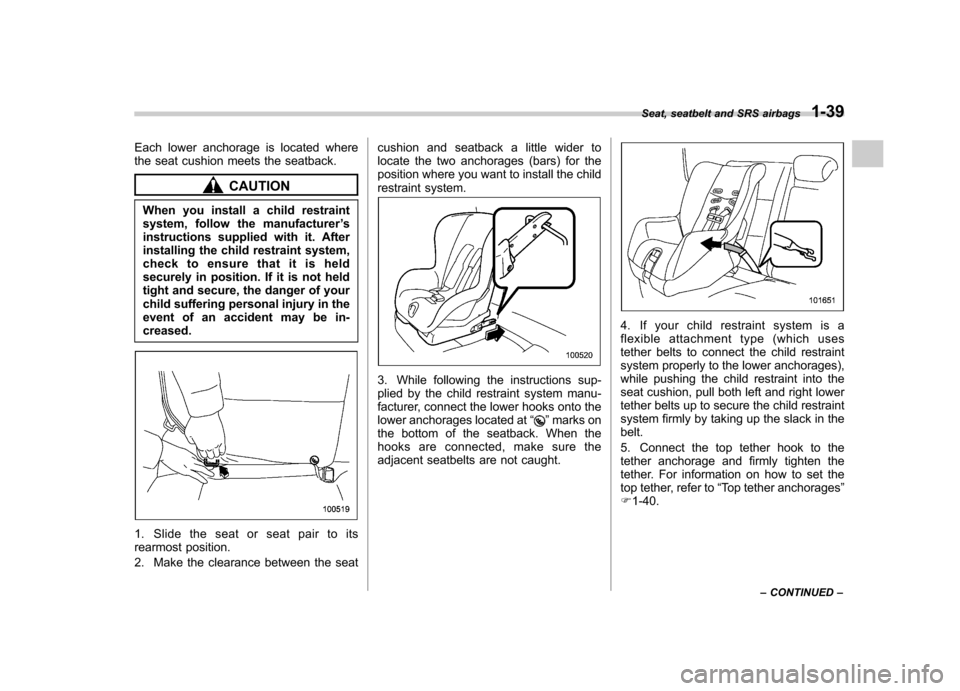
Each lower anchorage is located where
the seat cushion meets the seatback.
CAUTION
When you install a child restraint
system, follow the manufacturer ’s
instructions supplied with it. After
installing the child restraint system,
check to ensure that it is held
securely in position. If it is not held
tight and secure, the danger of your
child suffering personal injury in the
event of an accident may be in-creased.
1. Slide the seat or seat pair to its
rearmost position.
2. Make the clearance between the seat cushion and seatback a little wider to
locate the two anchorages (bars) for the
position where you want to install the child
restraint system.
3. While following the instructions sup-
plied by the child restraint system manu-
facturer, connect the lower hooks onto the
lower anchorages located at
“
”marks on
the bottom of the seatback. When the
hooks are connected, make sure the
adjacent seatbelts are not caught.
4. If your child restraint system is a
flexible attachment type (which uses
tether belts to connect the child restraint
system properly to the lower anchorages),
while pushing the child restraint into the
seat cushion, pull both left and right lower
tether belts up to secure the child restraint
system firmly by taking up the slack in thebelt.
5. Connect the top tether hook to the
tether anchorage and firmly tighten the
tether. For information on how to set the
top tether, refer to “Top tether anchorages ”
F 1-40.Seat, seatbelt and SRS airbags
1-39
– CONTINUED –
Page 69 of 420
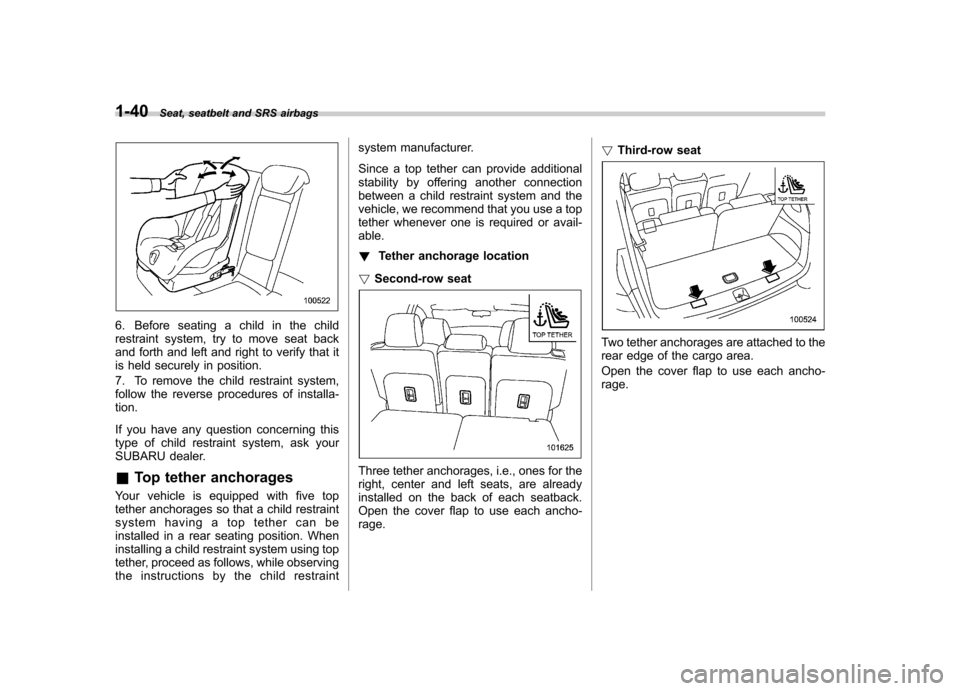
1-40Seat, seatbelt and SRS airbags
6. Before seating a child in the child
restraint system, try to move seat back
and forth and left and right to verify that it
is held securely in position.
7. To remove the child restraint system,
follow the reverse procedures of installa-tion.
If you have any question concerning this
type of child restraint system, ask your
SUBARU dealer. &Top tether anchorages
Your vehicle is equipped with five top
tether anchorages so that a child restraint
system having a top tether can be
installed in a rear seating position. When
installing a child restraint system using top
tether, proceed as follows, while observing
the instructions by the child restraint system manufacturer.
Since a top tether can provide additional
stability by offering another connection
between a child restraint system and the
vehicle, we recommend that you use a top
tether whenever one is required or avail- able. !
Tether anchorage location
! Second-row seat
Three tether anchorages, i.e., ones for the
right, center and left seats, are already
installed on the back of each seatback.
Open the cover flap to use each ancho-rage. !
Third-row seat
Two tether anchorages are attached to the
rear edge of the cargo area.
Open the cover flap to use each ancho- rage.
Page 70 of 420
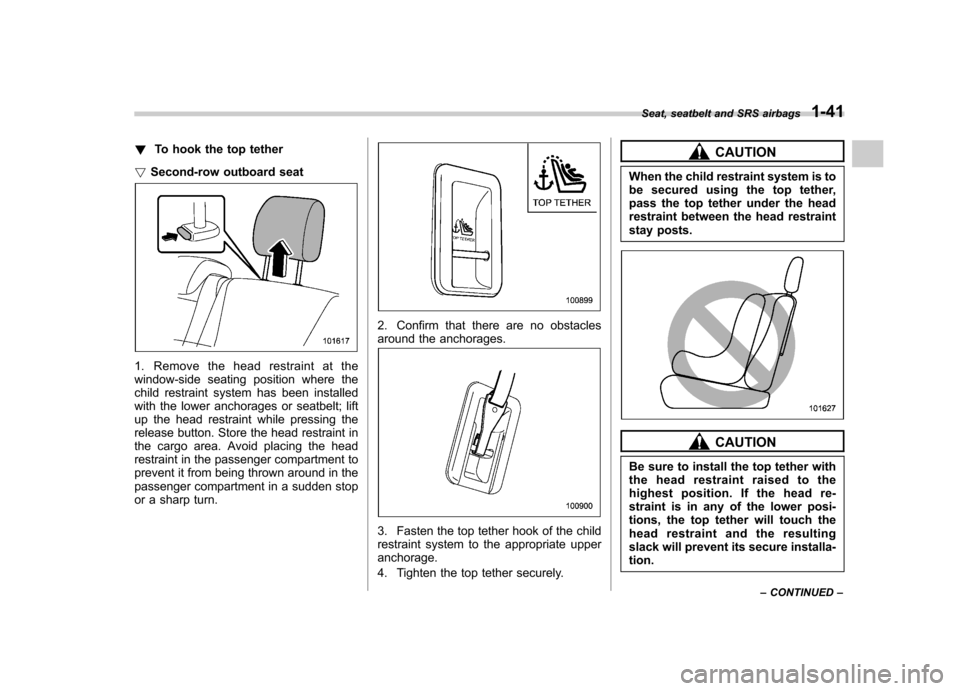
!To hook the top tether
! Second-row outboard seat
1. Remove the head restraint at the
window-side seating position where the
child restraint system has been installed
with the lower anchorages or seatbelt; lift
up the head restraint while pressing the
release button. Store the head restraint in
the cargo area. Avoid placing the head
restraint in the passenger compartment to
prevent it from being thrown around in the
passenger compartment in a sudden stop
or a sharp turn.
2. Confirm that there are no obstacles
around the anchorages.
3. Fasten the top tether hook of the child
restraint system to the appropriate upperanchorage.
4. Tighten the top tether securely.
CAUTION
When the child restraint system is to
be secured using the top tether,
pass the top tether under the head
restraint between the head restraint
stay posts.
CAUTION
Be sure to install the top tether with
the head restraint raised to the
highest position. If the head re-
straint is in any of the lower posi-
tions, the top tether will touch the
head restraint and the resulting
slack will prevent its secure installa-tion. Seat, seatbelt and SRS airbags
1-41
– CONTINUED –
Page 71 of 420
1-42Seat, seatbelt and SRS airbags
CAUTION
Do not route the top tether over the
head restraint. It may happen that
the top tether cannot be fastened
tightly. !
Second-row center seat1. Raise the head restraint to the highest
position at the seating position where the
child seat has been installed using the
seatbelt or lower anchorages; lift up the
head restraint while pressing the releasebutton.
2. Confirm that there are no obstacles
around the anchorages.
3. Fasten the top tether hook of the child
restraint system to the appropriate upperanchorage.
4. Tighten the top tether securely.